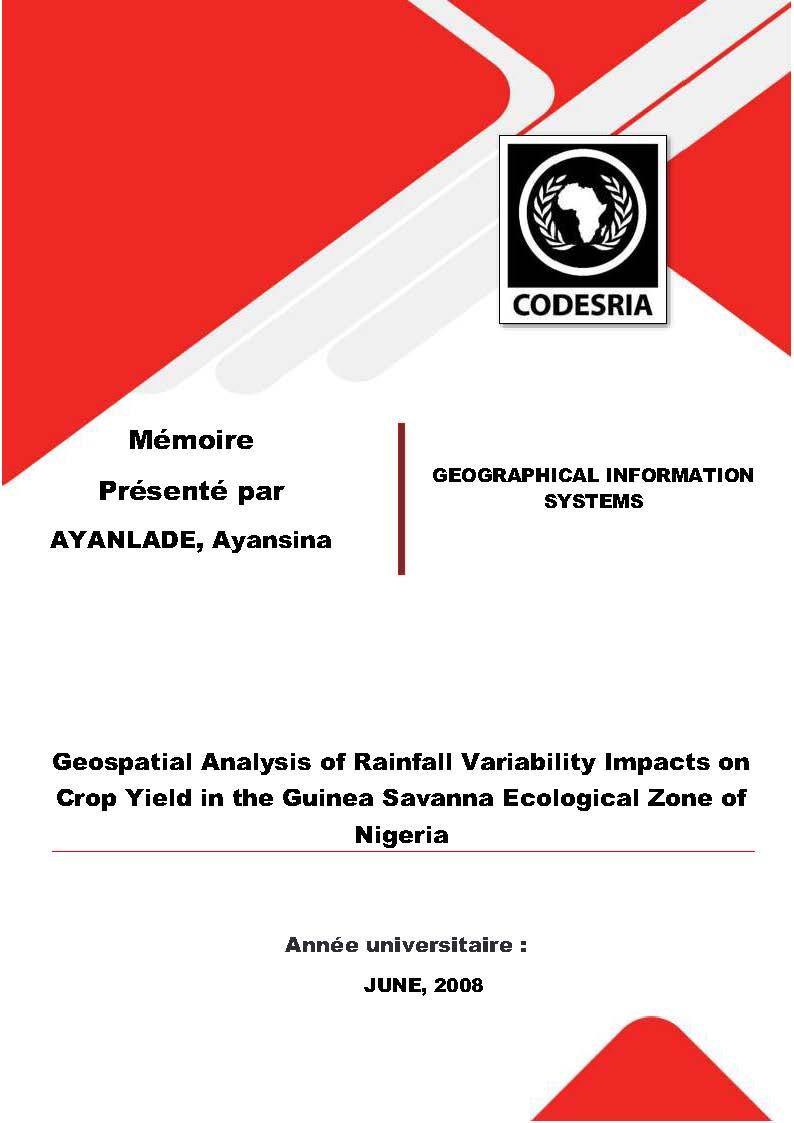Geospatial Analysis of Rainfall Variability Impacts on Crop Yield in the Guinea Savanna Ecological Zone of Nigeria
Keywords:
Geospatial, Analysis of Rainfall, Variability Impacts, Crop YieldSynopsis
The study developed a GIS database on inter-annual rainfall variability and crop yield in the Guinea Savanna ecological zone of Nigeria; mapped inter- annual changes in crop yield as a response to inter-annual rainfall variability in the study area. It also related the spatio-temporal variability in rainfall with crop yields; and model future scenario of the impact of rainfall
variability on crop yields. This was with a view to evaluating the spatio-temporal impacts of rainfall variability on crop yields in the area. Secondary datasets were used for the study. These included annual crop yield and rainfall data from 1970 to 2000 and topographical maps of the study area. Data on crop yield were obtained from the Annual Abstracts of Statistics of the National Bureau of Statistics, Abuja while rainfall data were collected from the Nigerian Meteorological Services, Oshodi Lagos. Spatial datasets were prepared as a base data for the analyses. Three spatial interpolation methods: Inverse Distance Weighting
(IDW); Spline and Kriging were used for the spatial analysis. Also, correlation and regression analysis were carried out on the dataset. The results showed spatial relationships between crop yield and rainfall variability for the period of study. Also, coefficient of variation showed that rainfall variability was high in most of Northern Guinea Savanna with values ranging from 21% to 49% (e.g. Yola 21% and Minna 29%) while it was low in the Southern Guinea Savanna especially, with values ranging from 8% to 9% (e.g Shaki 8% and Enugu 9%). The spatial variability in rainfall fluctuated from one year to the other (550mm to
2987mm). The results showed that there were significant positive relationship between crop yield and total rainfall (r=0. 68, at p<0.05 for millet; r= 0.62, at p<0.05 for maize; r= 0.68, at p<0.05 for cassava; and r= 0.62, at p<0.05 for yam). The results further showed that the quantity of rainfall in April and May were the most important for maize and millet yield in most of the stations considered. This indicated that in a “normal” year, farmers in the Guinea Savanna should not plant maize and millet earlier than
the month of April. The study concluded that geospatial techniques are powerful tools that should be explored further
for realistic assessment of the effects on climate of farming activities.
Downloads
References
Adejuwon, J.O. (2004): Crop yield Response to Climate Variability in the
Sudano- Sahelian Ecological Zones of Nigeria in southwestern
Nigeria. In AIACC Report of Workshop for Africa and Indian
Ocean Island. Dakar, Senegal, pp 15-16.
Adejuwon, J.O. (2005): Food Crop Production in Nigeria: Present effects of
Climate Variability. Climate Research, inter-Research, Germany.
Adejuwon, J.O. and Odekunle T.O (2004): Variability and Intensity of the “Little
Dry Season” in Southwestern Nigeria. In AIACC Report of
Workshop for Africa and Indian Ocean Island. Dakar,
Senegal, pp 8-9.
Adejuwon, J.O. and Odekunle T.O (2006): Variability and the Severity of the
“little Dry Season” in southwestern Nigeria. American Meteorogical
Society. Pp483-493.
Adesina, F.A.; Aina I.O and Adejuwon, J.O (2004): Existent Coping Strategies
in Adverse Environmental Condition as an Analogue for Adapting to
Climate Change in Rural Southwestern Nigeria. In AIACC Report of
Workshop for Africa and Indian Ocean Island. Dakar, Senegal, pp
-24.
Aina I.O and Adejuwon, J.O. (2004): Agronomic Adaptation to Climate
Extremes In AIACC Report of Workshop for Africa and Indian
Ocean Island. Dakar, Senegal, pp 20-21.
Anuforom, A. C., (2004). Rainfall Variability and Its Impact on Yield of Millet and Yam in Nigeria. Presented at the 30th International Post
Graduate Course at the WMO Regional Training Center, Bet-
Dagan, Israel.
Agbaje G.L and Akinlosotu T.A. (2004): Influence of NPK Fertilizer on Tuber
Yield of Early and Late-planted Cassava in a Forest Alfsoil of
Southwestern Nigeria. African Journal of Biotechnology Vol, 3
(10) pp 547-551, October 2004. Available online at
http/www.academicjournals.org/AJB.
Aronoff, S. (1989): Geographic Information System: A Management
Perspective WDL, Ottawa, Canada.
Awosika L., Ojo O. and Ajayi T. (1994): Implications of Climate Change
and Sea Level Rise on the Niger Delta, Nigeria – Phase 1.
A report for the United Nations Environmental Programme
OKAPIS/UNEP, 92 pp).
Ayeni, B (1995): Training Manual, Workshop on Geographical Information
Systems and Environmental Monitoring, GIS Workshop
Consultant to FEPA, Ibadan.
Ayoade, J.O (1988): Introduction to Climatology for The Tropics. Abiprint and
Pak Limited, Ibadan.
Badu-Apraku, B.,. Fakorede, M.A.B and Ajala S.O. (2002): Strategies of
WECAMAN to Promote the Adoption of Sustainable Maize
production technologies in West and Central Africa. African Crop
Science Journal Badu-Apraku, B.,. Fakorede, M.A.B and Ajala S.O. (2002): Enhancing human
resources for maize research and development in West and
Central Africa: A networking approach. Journal of Natural
Resources and Life Sciences Education (USA).
Buchanan, K.M and Pugh, J.C (1955): Land and People in Nigeria. University
of London Press Ltd, Warwick square, London, E.C.4
Burrough P.A (1990): Principal of Geographical Information
Systems for Land Resources Assessment. Claredon Press,
Oxiford.
Burrough P.A and Rachael A.M (1998): Principal of Geographical Information
Systems. Oxiford University Press.
Byerlee D. and Fisher K. (2000): Accessing Modern Science: Policy and
Institutional Options for Agricultural Biotechnology in Developing
Country. Agricultural Knowledge and Information Systems
(AKIS). Discussion paper. Washington D.C: World Bank.
Cai X and Roseges M.W (2002): Global Water Demand and supply
projections Part 1: A Modeling Approach. Water International
Vol. 27(3); pp 159-169.
Carter, T. R., M. L. Parry, H. Harasawa, and S. Nishioka. (1994).
Intergovernmental Panel on Climate Change (IPCC): Technical
guidelines for assessing climate change impacts and
adaptations with a summary for policy makers and a technical
sum-mary.London and Japan: Department of Geography






